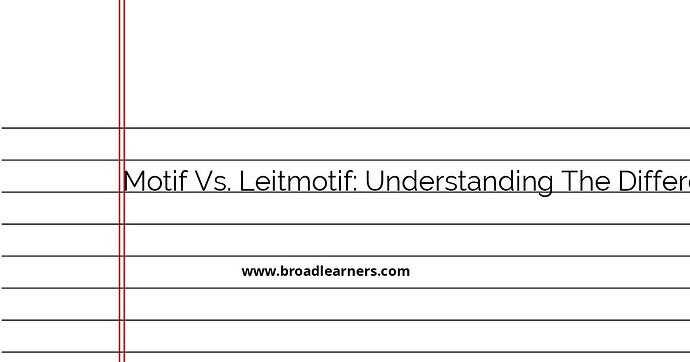Both "motif" and "leitmotif" are terms used in art and music to describe repeated elements that carry symbolic meaning. Though the terms are related, they have distinct meanings that separate them in usage and implication. Understanding these differences is crucial for anyone studying literature, music, or the arts. Here, we delve into the definitions and distinctions between motifs and leitmotifs, supported by examples to elucidate their respective uses:
- Motif
-
A motif is a recurring element, theme, subject, or idea that is especially noticeable throughout a work of art, literature, or music. This could be visual patterns, language repetitions, or musical themes that unify the artistic venture and underscore its main ideas.
Examples in Literature: In Shakespeare's Macbeth, repeated references to blood symbolize guilt and murder inherent to the tragedy's theme.
Examples in Music: The three short and one long note motif in Beethoven's Symphony No. 5 (often described as "fate knocking at the door") is an example of a musical motif that recurs throughout the composition.
- Leitmotif
-
A leitmotif is a specific type of motif, most commonly found in music, that is associated with a particular character, idea, or situation. Its primary function is to represent and recall the associated subject whenever it appears within the piece.
Examples in Music: Richard Wagner, the German composer, is credited with perfecting the use of leitmotifs in his operas. For example, in The Ring Cycle, individual characters or ideas have distinct melodies associated with them, such as the "Valkyrie Ride" representing the Valkyries.
Examples in Film: John Williams’ "Imperial March" in Star Wars serves as a leitmotif for Darth Vader and the oppressive regime.
Now let’s explore each term in more detail:
1. Understanding "Motif" in Various Contexts
Motifs are employed to add coherence and depth to a work. They reinforce a theme through repetition and create a sense of harmony and structure. In literature, a motif might take the form of a recurring literary device or subject matter, while in visual arts, it might appear as a repeated shape or color palette.
Example:
In F. Scott Fitzgerald's The Great Gatsby, the green light at the end of Daisy’s dock serves as a motif representing Gatsby’s hope and unattainable dreams.
2. Understanding "Leitmotif" and its Function
A leitmotif differs from a general motif in its direct association with specific entities or ideas. It is a more focused storytelling device, prevalent in operas and films, used to subtly bring back the elements it represents whenever it recurs, thus enriching the narrative with continuity and resonance.
Example:
In J.R.R. Tolkien's Lord of the Rings, Howard Shore uses specific musical themes as leitmotifs to represent characters like Gollum, Frodo, and the One Ring, enhancing their narrative arcs through the score.
Understanding motifs and leitmotifs and their respective roles enhances one's appreciation of the layered storytelling and emotional depth in creative works. Recognizing these devices allows audiences to experience and interpret the underlying nuances, making engagements with art more fulfilling.
Did I miss anything? Respond below
